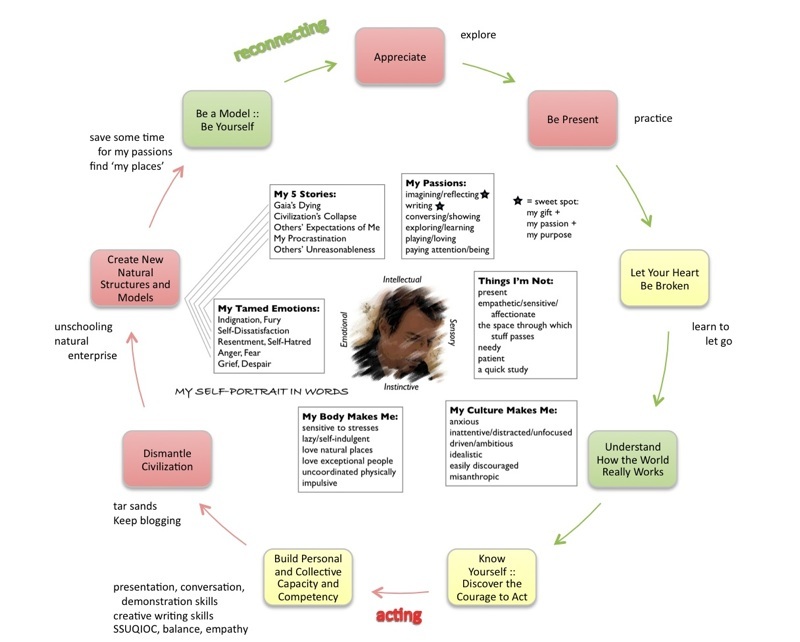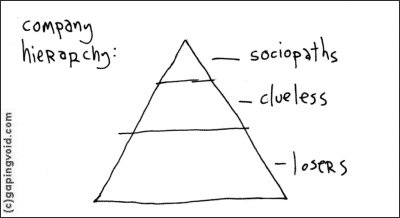
In my post last week I described Gil Fronsdal’s meditation on intentionality, and the value of setting both long term (What do you intend to do with what’s left of your life?) and short term (What do you intend to do, now, today, this week?) intentions, and getting them somehow aligned. Intentions are more than aspirations or resolutions, they are “stretching toward” commitments, directions toward something one hopes to achieve or at least move consistently and steadily closer to. But what do you do when you’re following a model (the one I adapted from Joanna Macy, pictured above) that has nine steps, and you have work to do in all nine areas? Can you have nine life intentions and nine short-term intentions, and really hope to accomplish more than a couple of them? Patti Digh and David Robinson talk about “split intentions”, when your actions are diffused, confused or distracted from achieving your intention. In workplaces these are rife — one set of personal actions is called for (in the mission statement or personal goals statement), while a very different, often incompatible set of actions is actually rewarded. Many large corporations, hoping to attract talent but keep that talent in thrall to the corporation’s more mundane objectives (constant growth and increased profitability for shareholders at any cost), recruit and internally propagandize on the basis of one set of behaviours, but quietly (or not so quietly) promote and remunerate employees for a very different set of behaviours. Ultimately, the true talent of the organization (those with vision, creativity and balance) catch on to the ruse and quit, leaving behind the bullies, the witless, and those too desperate, dependent or overextended to get out. Hugh McLeod has a brilliant cartoon depicting this: If you’re caught in this wage slavery hell, you will be living and breathing split intentions every day — not only between what the corporation says it wants and what it really rewards, but also between what it wants and what you want. The inevitable results are frustration, anger, self-hatred, disappointment and despair. Once your work day ends, more split intentions appear. You may aspire to do your part to combat climate change and become less dependent on our rapacious and unsustainable modern economy, but how can you do that when you and your partner need two cars to get to work from the only house you can afford, which is miles from your workplaces?: If you’ve escaped this hell, both in the corporate world and in your personal life, you still have the challenge of focusing in on one or two lifelong intentions, and really “stretching toward” them, and making sure that what you do each day moves you closer, while contributing at the same time to a lot of smaller but still important intentions, through actions that make the world a little better, for those you love, for strangers, and for all-life-on-Earth. In my personal “scorecard” at the top of this article I’ve scored myself (green/yellow/red) on each of the nine steps in the roadmap to reconnecting and acting that are needed to help the world cope with the coming collapse of civilization. My intentions towards each of these nine steps are the words around the outside of the circle: exploring appreciative enquiry, practicing presence, learning to let go, improving my presentation, demonstration, conversation and creative writing skills, becoming more grace-full, balanced and empathetic, stopping the tar sands, keeping this blog interesting and useful, helping develop useful working models of natural enterprise and unschooling, while saving some time to pursue my less ‘purposeful’ passions and find the places I’m meant to live. Several lifetimes’ worth of activities! And this is just a partial list of my intentions. After meeting some fascinating new people at a drum circle yesterday, I realized that one of the intentions missing from the Dismantle Civilization step for me is smashing industrial agriculture and specifically ending the atrocity of factory farming. Add that to my list of intentions. All my life I have struggled with having too many objectives, too many projects and intentions, and making far too little progress on any of them. I’ve tried the Getting Things Done approach, but concluded that my problem wasn’t (dis)organization or lack of focus, as much as an inability to say no. I’ve also become more sanguine about achieving measurable ‘results’ and ‘objectives’ as I’ve learned more about the nature of complexity and come to appreciate that most systems and challenges we face today are complex ones that don’t lend themselves to achievable objectives. The only sensible way to work on complex challenges is collaboratively, with others, and to see the work as continuous, work of learning and discovery, of coming to understand the ‘problem’ and possible approaches to it, simultaneously and iteratively. There is no mastery, there is only the practice. It’s been said that it takes 10,000 hours of practice at something to become highly competent at it. So how do I choose among fifteen or twenty intentions, all of which are important to me, when I will never have the time to learn and practice towards each of them, enough to be of any use to others at all? My intentions aren’t split, they’re fragmented.
Ironically, my reluctant answer is the answer that I have been saying for the past six months is not enough: helping people imagine a better way to live and make a living, principally through my writing. That’s what I’m most competent at. I need to work on appreciation, presence and letting go — letting my heart be broken and showing that broken heart to the world — but that is only (as Joanna Macy explains) the prerequisite work, the work of reconnecting, that must precede the work that really makes a difference. I should not wait to start the work of helping people imagine a better way to live and make a living, until I’m fully ‘reconnected’, though that reconnection will undoubtedly help the quality, value and accessibility of my work. I should also strive to improve my presentation, demonstration, conversation and creative writing skills because all of these will help improve and promote my work. And I do want to help dismantle civilization and help create new real-world models of natural enterprise, permaculture, transition culture and unschooling — but I’ve already acknowledged that my sweet spot is not creating these models but imagining and writing about them — telling stories about what is possible that others can realize. Last week Sharon Astyk, who is busy doing what I’ve been calling the ‘real work’ of creating these models (she’s working hands-on in permaculture and is connected to the transition movement and several activist causes) wrote about the importance of imagining a better world, rather than just rushing out to create it: People may agitate for climate change action now, but they do not fully grasp what it will entail – a change in way of life… In order for a majority of the world’s rich people… to choose less, to actually recognize that giving their children better means choosing a life of less, there has to be a vision of what the life constitutes – and it has to be immediately accessible.
Perhaps, in those words, I should find my marching orders. Of all the things I keep thinking and hoping are the things I’m meant to do, her words suggest that what I’m meant to do is to practice and get better, much better, at doing what I am already doing. So I just dusted off the outline of my novel of a post-civilization utopian culture The Only Life We Know. Five years since I started it. Still barely begun. Time to begin again. Sign up for workshops and practice lots of things that will make my work better, but spend time, every day, on my principal intention, what I want to be remembered for — helping people imagine a better way to live. How about you? Do you know what you’re meant to do? What’s your one intention, for what’s left of your life, something that you want to be remembered for, something that will be of use to others after you’re gone? What’s holding you back? Category: What You Can Do
|






Looking forward to the novel, Dave. It’s quite nice, if emotionally taxing, writing fiction – and you might be able to reach a different audience.K.
I just want to be remembered for making little kids laugh when they play with me. Because nothing makes me more happy.
By the way, Dave, keep on writing by all means. I am one of the many obscure Dave Pollard fans of the world that you inspire every now and then.
Hey Dave –My friend Tony wrote an interesting piece today about switching our attention from subverting, co-opting or rebelling to living alongside — ie, creating something new that can co-exist until civilization falls behind and ceases to exist. Maybe you’ll find something useful there to help decrease the number of intentions you feel are… necessary…Janeneps… I hope that link worked for a change ;-)
i have been numb and lost for 5 years now, i had a child and chose to leave my work as a graphic designer, to focus on my child and at that time i stumbled upon Derrick Jensen”s books, the veil of truth had been lifted and became depressed just waiting for civilization to come to an end. With the help of your blog and book, now after a long journey into fear, uncertainty and the feeling of helplessness(this was holding me back) i ‘m trying to find my sweet spot, I’m an artist, and love to make people feel good, help them through my art. I will see where this will take me. Maybe i shall go into art therapy? Remembered for giving and smiling through good and bad.thank you for all your good intentions.
Thinking about all those intentions . . . isn’t that how they pave the road to hell? We could shift to being excited by a possibility so that the possibility starts to live us. Flogging ourselves to do more hasn’t worked so well so far. It’s the context that’s decisive. Problem context means slogging; possibility context means adventure, when we live it with others.
Great article, Dave. This is my favorite sort of article you write. I think I share with you a desire to help people envision the world they most want. In fact, I just blogged a couple hours ago about using Tonglen as a practice that affects the subconscious and helps bring that vision to light for people. I also really look forward to getting together with you when you are in CA and gifting you with a spiritual energy channeling session. I have found that many people gain a lot of clarity and creative energization around their heart-paths over the 1-6 month period following the sessions. I suspect that will happen for you too, simply because I’ve seen it so many times. It’s funny but I think I want this session to happen more badly than you do – LOL
Actually, now that I’ve written that, I wish I could take it back, because I also recollect that it was the people with the least expectations of anything happening from the session (just giving it a “what the heck” shot) that seemed to get the most out of it. There is something about trying or expectation that seems to interfere with receptivity. So let’s leave it as me looking forward to it more than you ;-)